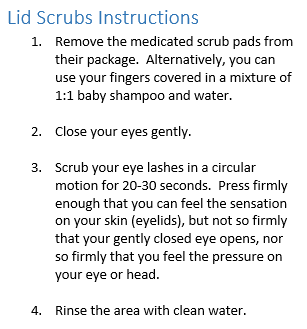Demodex: Benign Lid Mites
 Demodex is a benign mite infestation of the eyelids. They are benign because they cannot damage your vision permanently. In fact, these mites are part of the normal flora of most senior citizens (90% over 80 years old have them). However, they can cause irritation, redness, loss of eyelashes, and blurred vision due to dry eye. Demodex can be treated if symptoms are present; treatment is usually successful but can be painful.
Demodex is a benign mite infestation of the eyelids. They are benign because they cannot damage your vision permanently. In fact, these mites are part of the normal flora of most senior citizens (90% over 80 years old have them). However, they can cause irritation, redness, loss of eyelashes, and blurred vision due to dry eye. Demodex can be treated if symptoms are present; treatment is usually successful but can be painful.
What is a Mite?
A mite is much larger than bacteria or a virus. Mites are parasitic 8-legged animals that often cause irritation and can cause more serious health problems if the infestation is bad enough. Demodex are related to other common mites, such as lice. However, demodex are not as contagious as lice and rarely occur in people under the age of 70.
 Treatment
Treatment
Depending on the severity of the symptoms and infestation, treatment may be more or less recommended. If the case is mild, basic hygiene will usually take care of the problem. Adding lid scrubs to your morning and nightly routine in or outside of the shower can make a huge improvement. Depending on the severity, it may be recommended 1-3 times a day.
If lid scrubs are not effective or the infestation is very significant, hygiene using tea tree oil shampoo or tea tree oil-infused towelettes (such as Cliradex towelettes) may be appropriate. Using tea tree oil is much like performing basic hygiene, except tea tree oil is more effective against demodex, more expensive, and can be painful to apply.
 If tea tree oil is not completely effective or treatment is too painful, some antibiotics have proven to help limit the amount of demodex in the lids. Although mites are not bacteria, certain antibiotics have anti-inflammatory and anti-parasitic properties that can help boost your immune system's response to the mite infestation.
If tea tree oil is not completely effective or treatment is too painful, some antibiotics have proven to help limit the amount of demodex in the lids. Although mites are not bacteria, certain antibiotics have anti-inflammatory and anti-parasitic properties that can help boost your immune system's response to the mite infestation.
Oral Doxycycline is the oral antibiotic of choice. This behind-the-counter medication should be taken under the care of your optometrist. Side effects and drug-to-drug interactions can make doxycycline dangerous to use, so give your optometrist a full list of your current medications and follow their instructions on its use.
